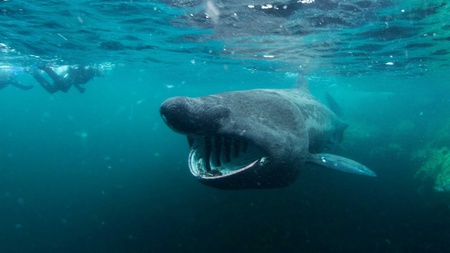The world's second biggest fish - the basking shark - prefers to travel with family to familiar feeding sites, according to a new study led by the University of Aberdeen.
The research, published today in Scientific Reports sheds new light on the migration routes of the sharks and outlines their vulnerability to environmental change.
Basking sharks can grow more than 10 metres long and were recently classed as ‘endangered’ on the IUCN Red List.
They feed on plankton and in the Northeast Atlantic, hundreds come together in surface waters during spring plankton blooms such as those that occur on the west coast of Scotland, Ireland and the Isle of Man.
Often seen near the coast, these sharks have been shown to cross ocean basins and equatorial regions, diving to depths of more than 1000m.
By developing a register of genetic profiles, the scientists were able to identify individual basking sharks when they arrived to feed. The results revealed that the fish repeatedly returned to the same feeding sites in successive years.
Dr Lilian Lieber, first lead author on the study of the research publication, now Research Fellow at Queen´s University Belfast, said: “Although developing genetic markers was challenging, the biggest obstacle to understanding how this endangered species uses the oceans was lack of DNA samples collected routinely from aggregations. At the start of our study, the relatively few available samples were from stranded sharks taken years and hundreds of kilometres apart, making them useless for population analyses.
“A breakthrough came when we discovered our techniques worked on skin mucus. We routinely swabbed aggregations of sharks quickly and with minimal disturbance, to obtain genetic profiles of individuals travelling together.”
Regular shark swabbing built up a register of more than 400 DNA profiles, requiring a major global collaboration across five oceanic regions.
Over 85% of samples were taken from free-swimming sharks at key sites in the Northeast Atlantic during the summer months.
Some sharks were re-encountered within seasons, and then again in following years; occasionally on approximately the same date in different years at sampling locations only kilometres apart. The study also points to the increasingly developed Irish Sea as an important migration route.
While the authors suggest that individuals of such a wide-ranging, long-lived filter-feeder are likely cosmopolitan, meaning groups are expected to mix and be genetically similar, comprehensive sampling revealed the first evidence of genetic differences between populations. Sharks sampled off Ireland in Spring, perhaps having overwintered near the US east coast, were genetically distinct from other Northeast Atlantic fish.
Widespread, regular sampling revealed basking shark groups consist of individuals more related to each other than the rest of the population, indicating a tendency to travel as extended family parties following prescribed seasonal migration routes.
Dr Catherine Jones of the University of Aberdeen, study co-lead, said: “Perhaps relatives hang out together, which could facilitate learning migration routes and encourage other cooperative behaviours. This means there´s more going on in basking shark aggregations than first appears in that they don't fit the shark stereotype of a lonesome independent predator.”
The northern European shelf hosts a plankton bonanza each year, making these areas a draw for basking sharks across the Atlantic, and possibly farther afield.
Professor Les Noble, co- lead, now at Nord University, Bodø, said: “Until this study the perception was they moved into warmer waters from globally distributed localities, sniffing out a plankton meal as they got closer to feeding sites, collecting in aggregations of unrelated sharks - like gourmets headed into town chancing on finding a good restaurant by smell. Now we know basking sharks book in advance at known Michelin starred venues, and take the family along!”
Finally, the study provides an important conservation relevant first, estimating a population size unlikely to exceed 10,000 individuals in Northeast Atlantic waters. This population´s vulnerability to environmental change will be increased by loss of important genetic differences carried by kin groups; making continued genetic sampling at key sites a vital monitoring tool in this era of rapid environmental change.
Dr Jones added: “Losing a group of kin together, such as occurs during accidental bycatch, erodes variation rapidly, making these big, slowly reproducing fish less capable of evolving to cope with environmental change. That, and a tendency to utilize areas currently designated for development of marine renewable energy, may not produce a happy outcome, unless we see intelligent management of marine environments.”


